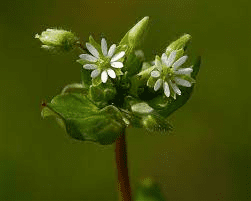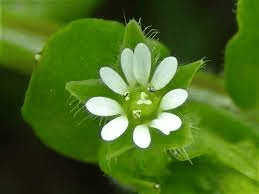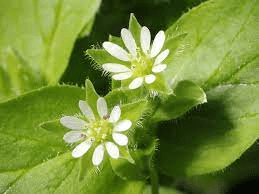Chickweed (Stellaria media) is a delicate and versatile herbaceous plant that belongs to the Caryophyllaceae family. Also known as common chickweed, it is widespread and can be found in various habitats, including gardens, lawns, and fields, earning it a reputation as both a weed and an edible herb.
Characterized by its small, star-shaped white flowers, chickweed typically grows low to the ground, forming dense mats with its succulent, oval-shaped leaves. The plant is identifiable by its fine, hair-like structures and pairs of opposite leaves along its stems.
Cultivated for centuries, chickweed is recognized for its culinary and medicinal uses. As a nutritious green, it can be consumed in salads, soups, or cooked as a leafy vegetable. Its mild, slightly sweet flavor adds a refreshing touch to dishes.
Beyond its culinary appeal, chickweed has a history of traditional medicinal use. It is believed to possess anti-inflammatory properties and has been used topically to soothe skin irritations such as itching and rashes. Additionally, chickweed has been employed in folk medicine for its potential diuretic and mild laxative effects.
Gardeners often appreciate chickweed for its ability to cover bare soil and provide ground cover, suppressing weed growth. Despite its reputation as a weed, its versatility and beneficial qualities make chickweed a plant of interest for both foragers and herbalists alike.
The Botanical Description of Chickweed
1. Life: Chickweed, scientifically known as Stellaria media, is a low-growing, mat-forming herb with delicate, paired leaves and small white flowers. Its stems are slender, and the plant typically reaches a height of 2 to 12 inches.
2. Leaves: The leaves of chickweed are oval-shaped, opposite each other along the stem, and have a distinct line of fine hairs. These hairs give the plant a soft, velvety texture.
3. Flowers: Chickweed flowers have five deeply lobed, white petals, and they are small, measuring about 1 cm in diameter. The flowers bloom throughout the spring and early summer.
4. Habitat: Chickweed is well-adapted to a variety of environments and can be found in gardens, fields, and disturbed areas. It thrives in moist, cool conditions but can tolerate a range of soil types.
5. Roots: The root system of chickweed is shallow, and the plant reproduces both by seed and by rooting at the nodes, allowing it to spread rapidly.
6. Growth Form: Chickweed’s growth form is sprawling and prostrate, forming dense mats that can cover large areas. This growth habit makes it easily recognizable in the wild.
7. Petioles: Chickweed leaves are attached to the stem by short petioles, and the stems often have a line of fine hairs known as a “fringe.”
8. Blooming Period: Chickweed typically blooms from late winter to early summer, producing an abundance of tiny flowers that add to its overall charm.
9. Edibility: Beyond its botanical characteristics, chickweed is also known for its edibility. It has a mild, slightly sweet taste, and both the leaves and flowers can be consumed raw or cooked.
The Geographic Distribution of Chickweed
1. North America: Chickweed is widespread in North America, found in various regions from the United States to Canada. It adapts well to different climates and soil conditions.
2. Europe: In Europe, chickweed is common and can be found in gardens, fields, and disturbed areas. Its adaptability has allowed it to establish itself in a variety of environments.
3. Asia: Chickweed has also made its way to Asia, where it can be found in countries with suitable climates and growing conditions.
4. Australia: In Australia, chickweed is present in certain regions, often in cool and moist habitats.
5. South America: While not native to South America, chickweed has been introduced to certain parts of the continent and can be found in localized areas.
6. Africa: Chickweed is less common in Africa compared to other continents but can be found in specific regions where it has been introduced.
7. New Zealand: Similar to Australia, chickweed has established itself in New Zealand, particularly in areas with favorable conditions.
8. Global Distribution: Chickweed’s adaptability and resilience have contributed to its global distribution, making it a familiar plant in many parts of the world.
The Chemical Composition of Chickweed
1. Nutrients: Chickweed is rich in essential nutrients, including vitamins A, C, and D, as well as minerals such as iron, calcium, and potassium.
2. Flavonoids: The plant contains flavonoids, which have antioxidant properties that contribute to overall health.
3. Saponins: Chickweed contains saponins, compounds known for their potential anti-inflammatory and immune-boosting effects.
4. Omega-6 Fatty Acids: The presence of omega-6 fatty acids in chickweed contributes to its anti-inflammatory properties.
5. Coumarins: Chickweed contains coumarins, which may have anticoagulant effects and contribute to cardiovascular health.
6. Triterpenoids: Triterpenoids found in chickweed have been studied for their potential anticancer properties.
7. Carotenoids: Chickweed contains carotenoids, which are beneficial for eye health and overall antioxidant support.
8. Alkaloids: Some alkaloids are present in chickweed, contributing to its bioactive profile.
9. Polysaccharides: Chickweed contains polysaccharides, which play a role in immune system modulation and overall health.
10. Amino Acids: Essential amino acids present in chickweed contribute to its nutritional value.
11. Essential Oils: Chickweed produces essential oils, adding to its overall composition and potential health benefits.
12. Organic Acids: The presence of organic acids in chickweed contributes to its unique taste and potential digestive benefits.
Read Also: 18 The Medicinal Health Benefits Of Sarsaparilla (Smilax officinalis)
The Medicinal Health Benefits Of Chickweed (Stellaria media)

1. Nutrient Boost: Chickweed is a nutritional powerhouse, providing essential vitamins and minerals that support overall health.
2. Anti-Inflammatory Properties: The presence of saponins and omega-6 fatty acids contributes to chickweed’s anti-inflammatory effects, potentially benefiting conditions like arthritis.
3. Skin Health: Chickweed has been traditionally used for skin conditions, such as eczema and psoriasis, thanks to its soothing and anti-itch properties.
4. Respiratory Support: Chickweed is believed to offer respiratory support, potentially helping with conditions like coughs and bronchitis.
5. Weight Management: The nutritional content of chickweed, coupled with its potential diuretic effects, may aid in weight management.
6. Immune System Boost: Chickweed’s flavonoids and polysaccharides may contribute to immune system modulation, enhancing the body’s defense mechanisms.
7. Digestive Health: The organic acids in chickweed may support digestive health, promoting a healthy gut environment.
8. Cardiovascular Health: Compounds like coumarins and omega-6 fatty acids may contribute to cardiovascular health by supporting blood circulation and reducing inflammation.
9. Antioxidant Support: The flavonoids and carotenoids in chickweed act as antioxidants, helping neutralize free radicals and reduce oxidative stress.
10. Wound Healing: Chickweed’s traditional use in promoting wound healing is attributed to its anti-inflammatory and skin-soothing properties.
11. Diuretic Effects: Chickweed’s diuretic effects may assist in flushing out toxins and promoting kidney health.
12. Blood Sugar Regulation: Preliminary research suggests that chickweed may have potential benefits in regulating blood sugar levels.
13. Anxiety and Stress Relief: Some herbalists suggest that chickweed may have mild calming effects, contributing to stress and anxiety relief.
14. Joint Health: Chickweed’s anti-inflammatory properties may be beneficial for joint health and conditions like arthritis.
15. Eye Health: The carotenoids in chickweed contribute to eye health, supporting vision and reducing the risk of age-related eye conditions.
16. Anticancer Potential: Some studies explore chickweed’s potential anticancer properties, although more research is needed for conclusive evidence.
17. Hair and Scalp Care: Chickweed’s soothing properties may extend to the scalp, promoting healthy hair and addressing certain scalp conditions.
18. Anti-allergic Effects: Chickweed’s anti-inflammatory properties may help alleviate symptoms of allergies and allergic reactions.
19. Hormonal Balance: Traditional uses suggest that chickweed may contribute to hormonal balance in certain contexts.
20. Antimicrobial Actions: Chickweed may possess antimicrobial properties, supporting the body’s defense against infections.
The Methods of Usage to Achieve the Provided Health Benefits Of Chickweed (Stellaria media)
1. Culinary Use: Incorporate chickweed into salads, soups, or smoothies to harness its nutritional benefits.
2. Infusions and Teas: Prepare chickweed infusions or teas to enjoy its potential respiratory and immune system benefits.
3. Topical Applications: Create poultices or creams with chickweed for skin-related concerns, such as itching or minor wounds.
4. Tinctures and Extracts: Extract chickweed’s bioactive compounds by preparing tinctures or extracts for convenient usage.
5. Herbal Supplements: Consider chickweed supplements, available in various forms, for a more concentrated dose of its benefits.
6. Steam Inhalation: Inhale steam infused with chickweed for respiratory support, especially during cold and flu seasons.
7. Poultices for Joint Health: Apply chickweed poultices to joints for potential relief from inflammation and arthritis symptoms.
8. Hair Rinses: Use chickweed-infused rinses for the hair and scalp to promote healthy hair and address certain scalp conditions.
9. Infused Oils: Prepare infused oils with chickweed for external use, such as massages or skin treatments.
10. Culinary Creativity: Experiment with chickweed in various culinary dishes to explore its unique taste and nutritional benefits.
The Side Effects Of Using Chickweed Medicinal Plant
1. Allergic Reactions: Some individuals may experience allergic reactions to chickweed, especially those sensitive to plants in the Caryophyllaceae family.
2. Digestive Discomfort: In rare cases, excessive consumption of chickweed may lead to digestive discomfort, including nausea or diarrhea.
3. Skin Sensitivity: Topical application of chickweed may cause skin sensitivity in certain individuals; perform a patch test before widespread use.
4. Drug Interactions: Chickweed may interact with certain medications, particularly anticoagulants or blood-thinning drugs; consult healthcare professionals if taking such medications.
5. Pregnancy and Breastfeeding: Pregnant and breastfeeding individuals should exercise caution when using chickweed, and professional guidance is recommended.
6. Kidney Conditions: Individuals with kidney conditions should be cautious with chickweed due to its diuretic effects; consult healthcare providers for advice.
7. Photosensitivity: Chickweed may increase sensitivity to sunlight in some individuals; use sun protection when using chickweed topically.
8. Respiratory Conditions: While chickweed is traditionally used for respiratory support, individuals with respiratory conditions should seek professional advice before use.
9. Internal Use Moderation: Consume chickweed internally in moderation to avoid potential adverse effects, especially if used in concentrated forms.
10. Excessive Diuretic Effects: Excessive consumption of chickweed may lead to increased urine production; monitor hydration levels accordingly.
11. Blood Pressure: Chickweed’s potential effects on blood pressure should be considered, especially for individuals with hypertension.
12. Children’s Usage: Use chickweed cautiously in children, and consult healthcare professionals before incorporating it into their routine.
13. Interaction with Antidiabetic Medications: Chickweed may influence blood sugar levels; individuals taking antidiabetic medications should consult healthcare providers.
Read Also: Are Honey Bees Aggressive?
The Scientific Research and Studies of Chickweed (Stellaria media)

1. Antioxidant Activity: Scientific studies have explored chickweed’s antioxidant properties, attributing them to its flavonoid and carotenoid content.
2. Anti-Inflammatory Effects: Chickweed’s potential anti-inflammatory effects have been investigated, with some studies suggesting benefits for conditions like arthritis.
3. Antimicrobial Properties: Research indicates that chickweed may possess antimicrobial properties, contributing to its traditional use in wound healing.
4. Respiratory Health: Some studies explore chickweed’s potential benefits for respiratory health, including its traditional use in managing coughs.
5. Nutritional Profile: Scientific analysis has confirmed chickweed’s rich nutritional profile, emphasizing its value as a nutrient-dense herb.
6. Diuretic Effects: Chickweed’s diuretic effects have been studied, supporting its traditional use in promoting kidney health.
7. Anticancer Potential: Preliminary research suggests that certain compounds in chickweed may have anticancer properties, although further studies are needed.
8. Cardiovascular Health: Chickweed’s potential contributions to cardiovascular health have been investigated, focusing on its omega-6 fatty acids and coumarin content.
9. Traditional Uses Validation: Scientific studies often aim to validate the traditional uses of chickweed, providing a scientific basis for its historical applications.
10. Skin Health Benefits: Some studies explore chickweed’s benefits for skin health, supporting its traditional use in addressing skin conditions.
11. Immunomodulatory Effects: Research indicates that chickweed’s polysaccharides may have immunomodulatory effects, contributing to immune system support.
The Safety Precautions and Recommendations In Using Chickweed (Stellaria media) Medicinal Plant
1. Allergy Testing: Perform a patch test before using chickweed topically to check for potential skin sensitivity or allergic reactions.
2. Consultation with Healthcare Professionals: Individuals with existing health conditions, pregnant or breastfeeding individuals, and those on medication should consult healthcare professionals before using chickweed medicinally.
3. Moderation in Internal Use: Consume chickweed internally in moderation, especially in concentrated forms like extracts or supplements.
4. Children’s Usage Caution: Exercise caution when using chickweed in children, and seek professional advice before incorporating it into their routine.
5. Monitoring for Adverse Effects: Monitor for any adverse effects, such as digestive discomfort, skin irritation, or allergic reactions, and discontinue use if they occur.
6. Photosensitivity Awareness: Individuals using chickweed topically should be aware of potential photosensitivity and take appropriate sun protection measures.
7. Kidney Conditions Caution: Individuals with kidney conditions should be cautious due to chickweed’s diuretic effects; professional advice is recommended.
8. Interaction with Medications: Chickweed may interact with certain medications, especially anticoagulants or blood-thinning drugs; consult healthcare providers if taking such medications.
9. Pregnancy and Breastfeeding Caution: Pregnant and breastfeeding individuals should use chickweed with caution, and professional advice is recommended.
10. Blood Pressure Monitoring: Individuals with hypertension should monitor blood pressure due to chickweed’s potential effects.
11. Gradual Introduction: Introduce chickweed products gradually to assess individual tolerance, especially for internal use.
12. Respiratory Conditions Caution: Individuals with respiratory conditions should use chickweed with caution and seek medical advice if needed.
FAQs About Chickweed (Stellaria media) Medicinal Plant
1. Is Chickweed Safe for Regular Consumption?
Yes, chickweed is generally safe for regular consumption when used in moderation. However, individual reactions may vary, and it’s advisable to start with small amounts.
2. Can Chickweed be Used During Pregnancy?
Pregnant individuals should exercise caution when using chickweed. Consultation with a healthcare professional is recommended to ensure safety during pregnancy.
3. How Can Chickweed be Included in Culinary Dishes?
Chickweed can be added to salads, soups, and smoothies to enjoy its nutritional benefits. Ensure proper washing before consumption.
4. Is Chickweed Suitable for Children?
While chickweed is generally considered safe, it’s important to exercise caution with children. Consult healthcare professionals before incorporating it into their routine.
5. Are There Any Known Drug Interactions with Chickweed?
Chickweed may interact with certain medications, especially anticoagulants or blood-thinning drugs. Consult healthcare providers if taking such medications.
6. Can Chickweed Help with Skin Conditions?
Chickweed has been traditionally used for skin conditions due to its soothing properties. Topical applications like poultices may be beneficial.
7. What Precautions Should be Taken for Topical Use of Chickweed?
Perform a patch test before widespread topical use to check for skin sensitivity. Use sun protection, as chickweed may increase sensitivity to sunlight.
8. Is Chickweed Suitable for Individuals with Kidney Conditions?
Individuals with kidney conditions should be cautious due to chickweed’s diuretic effects. Professional advice is recommended before use.
9. How Does Chickweed Contribute to Respiratory Health?
Chickweed’s potential benefits for respiratory health may be attributed to its traditional use in managing coughs. Steam inhalation or teas may offer support.
10. Can Chickweed be Used as a Hair Treatment?
Yes, chickweed-infused rinses or oils can be used for hair and scalp care. These applications may promote healthy hair and address certain scalp conditions.
11. Is Chickweed Safe for Individuals with Allergies?
Some individuals may be allergic to chickweed, especially those sensitive to plants in the Caryophyllaceae family. Allergy testing is recommended.
12. How Does Chickweed Support Cardiovascular Health?
Chickweed may contribute to cardiovascular health through its omega-6 fatty acids and coumarin content. However, individual responses may vary.
13. Can Chickweed Help with Weight Management?
The nutritional content of chickweed, combined with its potential diuretic effects, may contribute to weight management goals.
14. Is Chickweed Beneficial for Joint Health?
Chickweed’s anti-inflammatory properties may offer benefits for joint health, potentially assisting with conditions like arthritis.
15. How Should Chickweed Supplements be Taken?
Chickweed supplements are available in various forms. Follow the recommended dosage on the product label and consult healthcare professionals if needed.
16. Does Chickweed Have Anticancer Properties?
Preliminary research suggests that certain compounds in chickweed may have anticancer properties. However, more studies are needed for conclusive evidence.
17. Can Chickweed Help with Digestive Health?
The organic acids in chickweed may support digestive health. Culinary use or teas may be effective in promoting a healthy gut environment.
Read Also: Design Criteria, Advantages and Disadvantages for Grit Removal

